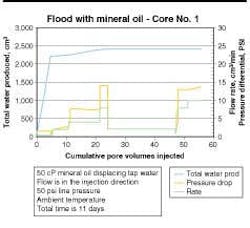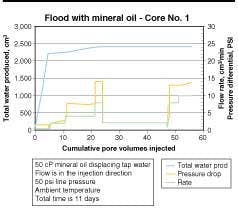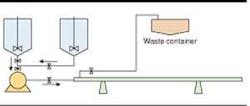Invert gravel-pack carrier fluid system designed for density without solids
Invert fluids and all-oil and synthetic drilling fluids are being used in high-angle wells, which can be excellent candidates for gravel packing. The practice has led to a need for a complete fluid system to drill and gravel pack the reservoir, which has led to the development of systems that are compatible with drilling fluids and can provide the highest degree of formation damage protection.
It is common practice to drill the producing intervals with a specialized fluid engineered to minimize formation damage and to cleanup by placing the well on production. After drilling this producing interval, whether with a water-based or invert-based system, the reservoir drilling fluid is typically displaced with completion brine.
Modern thought is that the completion starts when the bit enters the producing interval. After displacement, the well is circulated until solids have been removed and returns are cleaned to an optimum level before running in with the completion assembly. If the well is to be gravel packed, properly sized gravel will be pumped into the annular section between the completion assembly and the wellbore.
During the cleanup/circulation phase of the operation, the filter cake, from a properly engineered reservoir drilling fluid, can be eroded to a very thin sub-millimeter thickness without compromising fluid-loss control. The filter cake can still sustain high differential pressure - verified by large-scale lab testing and actual field results.
When a well is put on production, the produced fluids will break through the filter cake, and a very tiny impediment to flow is left behind. If a remedial cleanup treatment is required to remove the filter cake, this cleanup is normally carried out before placing the well on production. This remedial treatment can be performed after the well begins producing.
Until recently, horizontal wells drilled with an invert system where still gravel was packed with completion brine. The industry's perception is that displacing from an invert system to water-based completion brine is fraught with difficulty under the best circumstances. Common problems are, but not limited to:
- Incompatibility of drilling fluid with completion fluid
- Formation incompatibilities
- Formation of precipitates
- Potential for creating a sludge/emulsion.
While good displacement techniques and practices can avoid these problems, an associated risk still exists. Operators now have a new option for completing wells after they have been drilled with invert drilling fluids. With the invert gravel-pack fluid (IGPF) system, operators can displace invert drilling systems with invert completion fluids, which are then used for gravel packing the well. According to tests, this fluid should be compatible with the drilling fluid system(s) displaced and the zone being completed.
Halliburton's Baroid Research and Development Center developed the invert system to enhance the completion process. The invert system is an integral part of the drilling and completion package, which can provide better productivity results. The primary challenge was to design an invert system with high density, but without using solids as weighting agents.
Additionally, the system needed to have low rheology properties to allow IGPF to be used as a carrier in high-rate gravel packing applications used in longer horizontal intervals. Several of the primary developmental goals are:
- High-density invert without solids
- Stable emulsion with minimal emulsifier
- Passive emulsifier, minimizing wettability concerns
- Filterable with conventional equipment while gravel packing
- Low rheological properties for high rate gravel pack applications
- Compatible with invert drilling fluids
- Compatible with reservoir fluids.
The system was designed for low rheology, but if required, the rheology can be increased by modifying the product mix or by adding polymers that are compatible with the system.
Potential concerns
As with any gravel-pack fluid, there are always concerns about performance and manageability. Some of these concerns can include:
- Fluid rheology?
- Fluid effect on the gravel-packing process: will the fluid be able to transport proppant in a high-rate gravel pack?
- Will properties remain constant?
- What is the stability of the emulsions?
- Can the fluid be filtered and reclaimed, preferably with conventional equipment?
These concerns have been addressed by large-scale testing on gravel-packing simulators. Issues relating to compatibility with the filter cake were addressed by testing in a radial flow cell.
IGPF appears to provide proppant transport equal to or better than water. In the case of gravel packing with water, turbulence and eddy currents were observed. In some tests, excessive turbulence has been shown to cause premature screenout. The system reduces these turbulence effects, leading to a smoother proppant placement process. The final gravel packs of both fluids indicated that the gravel was tightly packed in the model without any voids in the main screen section.
Evaluation of samples obtained from filtration passes show that system properties remained stable after several passes. Additional analyses of fluid samples, including permeability measurements, indicated no damage to the permeability of the 20/40-mesh sand pack by regaining more than 99% permeability.
Radial flow test
The mud formed an effective seal and was nondamaging to the core material tested. Erosion by invert gravel-pack fluid did not compromise the filter cake, and breakout pressure was very low.
Initial displacement of the mud before exposure to the invert gravel-pack fluid should be improved. A high-viscosity sweep ahead of the invert gravel-pack fluid could improve cleaning.
Core test scanning proved helpful for understanding the erosion part of this test as well as fluid distribution in the wellbore region after production. This scanning should be incorporated into any future testing.
Good mixing and storage facilities are important to field implementation. For field applications, when the density requirement is specified, testing should be performed to help ensure that the correct fluid properties are determined for the given project. This can be the key to the success of the system. After the fluid has been mixed and sheared, a precise protocol will be applied for the displacement of the invert drilling fluid to the system. This process, while detailed, should be easier to execute without the difficulties that have been experienced when displacing from an invert drilling system to completion brine for the gravel-packing stage.
The 12-ft gravel-pack model was made from Lexan material, which is transparent for ease of observation during the gravel placement. There was no leakoff port added to the wall of Lexan tube to simulate leakoff through perforations. A 1.75-in. outside diamter (OD) wire-wrapped screen was used for testing. Gravel-packing was performed by pumping slurry down the borehole screen annulus while taking returns through a washpipe (0.875-in.OD).
In an effort to duplicate field mixing, a yard test was conducted involving plant-mixing facilities and plant filtration on a volume of 200 bbl. The system products were mixed in a precise order and sheared in the mixing tank. Next was to shear the whole fluid from one tank to another, catching samples of the sheared fluid after each pass.
The results were that the rheological properties increased slightly while density remained constant. Also, the electrical stability increased slightly after each pass, indicating that the emulsion stability was increasing. The fluid was also successfully filtered through a diatomaceous earth filter unit.
Intensive laboratory testing has provided data to support the use of the system as an alternative fluid to brines as a gravel-carrier fluid. The system can be designed with low rheology or, for alternate path screens, can be readily viscosified to help enhance gravel transport. The IGPF system is compatible with oil-based muds/synthetic-based muds, and can provide density without the use of solids, from 6.6 to 12.2 ppg.
Editor's Note: This is a summary of the SPE 71669 paper, prepared for presentation at the 2001 SPE Annual Technical Conference and Exhibition (New Orleans, La., September 30-October 3, 2001).


